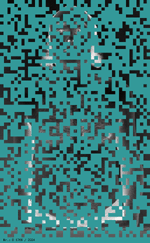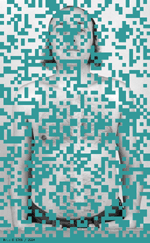

 |
|||||||||||||||||||||||||||||||
|
| |||||||||||||||||||||||||||||||
|
STATEMENT: "You may open three pages now. Only you are able to see, what you are going to see, nobody else gets the same view. It is a unique threefold piece of art, which you may print out. for your collection. It shall be numbered and signed simultaneously in the moment of printing. The first page is an image of My Self (1969), which loses "one pixel" the moment you open it. You can hear and see this. On a second page you will find that pixel, you managed to lose, at its original position, but only this, your personal one. On a third page all the pixels lost by you or other users, add up to another image, which is a positive of the first negative print with a slight difference. My Self seemed to vanish and returns now. Please, if you wish, sign in in the community of collectors: the Public Collection. Only in the totality of all the globally distributed fragments, the entire process of going and coming of My Self can be imagined as a new piece. Leave your name, location and country later." (Wolf Kahlen) Thus, in Kahlen's work, are we asked not only to help, but also to participate in the transubstantiation of the artist's body. Like a Christ, martyr of the Internet, the artist metaphorically dies and resuscitates through the user's clickings, like so many prayers or votive offerings, heard and fulfilled, to assist the penitent in his ascent to the heavens. The religious reference is obvious in itself (the commentary published in Rhizome rightly speaks of "ritual death" in qualifying the work). The photograph of the artist represents him from midsection to face, arms along the body, and recalls (among other recumbent figures) the mystery image imprinted on the shroud of Turin. Does the world of the Web then resemble Paradise? It certainly seems to carry the promise of eternal life, or at least of a certain extension of life after death - the body's real death being denied, to a some degree, by the persistence of the virtual body. One must also keep in mind that the image of the artist's body offered for manipulation, for consumption, and thus for quasi-religious transubstantiation, dates from 1969. Therefore, in this offering of a self-image - and consequently of the artist's self ("My Self," Kahlen repeats in his presentation) -, one also finds here a recreation of the human body's inevitable deterioration over a period of more than thirty years - the work's title, 1969 Selbst-los / Self-less 2000, in which the dates (of origin and. . . (temporary) end?) are carefully noted, underscores the passage of time, for each and everyone of us). But, at the same time, another endeavour emerges in this work, the human, all-too-human, attempt to bypass and out-play this inevitable decline of the body, and worse, that of the self that accompanies it in old age and death, by inventing another body, a body of pixels, a body of light. What is remarkable here is that this invention is not a solitary one. On the contrary, it needs, and demands, the participation of others, of a community of surfers and art enthusiasts, each of whom may well take with them an ever-unique and personal work, the testimony of their contribution, but nevertheless a work that belongs to no-one because it participates in, is but a state of, the virtual work that remains that of everyone. Thus, Kahlen appears in this work not only "impassioned" (in the literal sense, if one may say, of an object of quasi-religious passion), but also takes on airs of a prophet and reformer against an institution, which, like a church too petrified in its traditions, is certainly in need of reassessment, that is, the institution of the art world. And the Web seems like a well-suited medium for the task: through such expediency does Kahlen produce virtual works, unique, aleatory, community-based, and non-marketable; doing so, he finds his own salvation, his salvation in immortality, in the persistence of pixels that ceaselessly recreate his image, as a human being and as an artist. It is in this sense that Kahlen's 1969 Selbst-los / Self-less 2000 is not only an aesthetic and conceptual endeavour, but an authentically ethical one.
Anne-Marie Boisvert
|
||||||||||||||||||||||||||||||

